
Aardman’s first stop-motion holiday special of 2021 is Robin Robin, about a robin, a magpie and a wish for a joyous Christmas. It premieres Wednesday November 24th on Netflix. Directors Dan Ojari and Mikey Please spoke with me from the iconic U.K. animation studio about getting Robin Robin off the ground and how it will glide right into our hearts. (This Animation Scoop Q&A was edited for length and clarity.)
Jackson Murphy: Dan, why do you think animated holiday specials — especially stop-motion ones — are so beloved around the world?
Dan Ojari: I think there’s probably some element of… you can see the craft in them. You can see that a person’s made them. It’s very visible. You’re aware of the materials. There’s probably a part of you that thinks “Oh maybe I could make something like that as well.” It’s very inclusive. There’s an intimate charm that resonates around Christmastime. It’s such a brilliant tradition and lovely stage to tell a story on. Families welcome these films and stories into their lives every year, and if you’re very lucky, that’s something like The Snowman and a lot of Wallace & Gromit films that are re-watched every year and cherished.
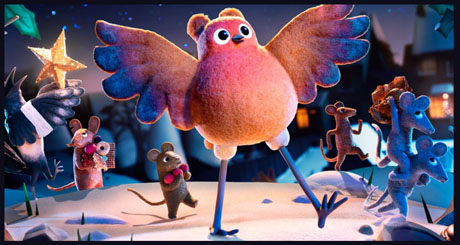
JM: Intimacy and charm – I completely agree. Robin Robin is about a robin, named Robin. She’s raised by mice. It’s quite a Christmas adventure. Mikey, what were your goals in creating her emotional arc and emotional journey?
Mikey Please: Her emotional journey… evolved as we set about making the film. The very initial kernel of the idea was this robin who’s raised by this family of burglar mice. She doesn’t quite fit in but gets separated and goes out on this journey to try and find her way home and meets this magpie. They have this adventure and in the end she learns more about herself and becomes more accepting of who she is. But as we developed the film, that initial idea becomes quite changed, actually, from what we have in the final film. There are [still] the tentpoles of the story there but the emotional core of Robin accepting that what makes her different is actually a really positive thing, once she embraces it (Our differences make us stronger ): that took a while to really crystalize. But once we got it and we put that armature through the film, it held together beautifully.
JM: I really like Richard E. Grant’s voice performance as Magpie. And what you’re able to do is: you make Magpie confident but he’s not cocky in an annoying or discouraging way. Dan… you walk that tightrope and succeed with that.

Dan Ojari
JM: The humor is this dry, quirky, unexpected humor that comes in specific places. And one of the other really impressive elements is the sound work. All the objects. All the *things* Magpie has. The sound work is spectacular. Mikey, what were some of the most difficult aspects of pulling off the sound work?
MP: It’s an incredible sound design-scape. We watched it with just the sound design on before we went into the final mix. It’s a wonderful experience doing that because suddenly this big rambunctious musical romp becomes this super arthouse film, which is really amazing. The film you have is like a ghost but… once you put the sound design on it – once you get textures rubbing – suddenly the ghost becomes a full, meaty, living thing.
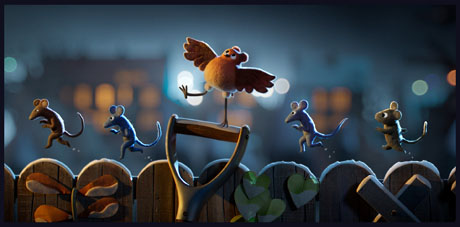
JM: This is a musical, which is new for Aardman. Dan, can you talk a little bit about The Bookshop Band and what they were able to do with these really unconventional rhythms and lyrics that are really refreshing?
DO: We hadn’t made a musical before and we embraced the fact that most of the team who were making this musical hadn’t made a musical before. We wanted to make something that felt very centered in folk music and world music that The Bookshop Band brings to it. And that sense of melody and emotion – we were very confident that they would be a brilliant team to create the score and the melodies within the film. That’s why it ended-up as a non-conventional musical.
JM: It’s memorable music. A couple months ago I had the chance to watch a virtual presentation you two were a part of. And one of the things mentioned in it was that Gillian Anderson’s character, the Cat, is “a massive puppet”. Now Mikey, how massive are we talking?
MP: She’s right behind me here. (Mikey shows me the Cat puppet.) She’s large. She’s a very, very large puppet. Slightly larger than a life-size cat.
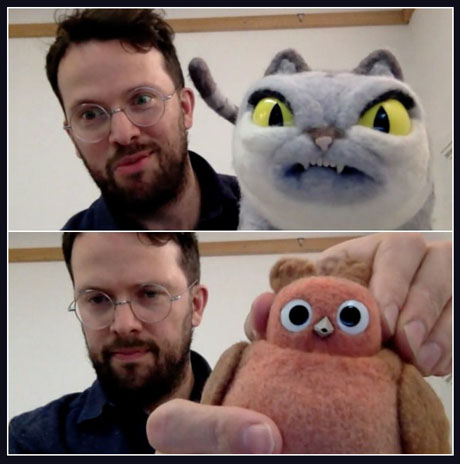
Mikey Please and his pals
JM: I was gonna say fairly close to the size of a cat.
MP: Yeah. Inside there’s this absolutely incredible dynamic… basically like a robot built by the incredible armatures team here. She’s a feat of engineering – able to elongate and contract. She has movable shoulderplates that go automatically when her knee joints bend. So much engineering goes into these things. It’s a real marvel.
JM: The way Cat comes in – the way she moves and the way her head and body go are so unique. One of the other things we really have to talk about is that you’re using felt for these characters, which is also something bold for Aardman. Dan, what does felt give you that clay really can’t?
DO: Good question.
MP: You’re not allowed to bad-mouth clay, though.
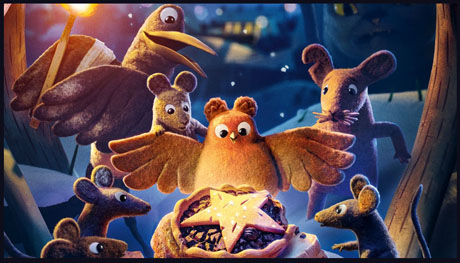
JM: (laughs) I’m not bad-mouthing clay!
DO: They have similarities in certain qualities. What we really love in felt… and it has a similar quality to plasticine but in a different way… you put it on camera and the way that it lights and it’s a fabric and you can see all the details, it feels like a tactile, very real material that you could reach out and touch. Part of the magic of stop-motion is when one eye kind of knows what material it is and you can see that it’s a real, physical thing that shouldn’t move and the other eye is seeing that it’s moving and it’s breathing and it’s alive. It’s a really brilliant magic trick when that illusion happens. We were really keen to use a material that you knew what that material was. If you use silicon, which you can use in brilliant ways, but sometimes if you push it so slick you don’t know the material anymore. The illusion of knowing what it is and the movement is lessened.
JM: And I’m sure a lot of details also went into the book that is gonna be released. Mikey, how was it putting this book together?
MP: Such a dream come true. We worked with [illustrator] Briony May Smith, who was our very first collaborator on the project, before it even came to Aardman. We got in touch with Briony and she made the most beautiful concept art and came around with us to the various pitches. We were able to work with her again on the picture book, which was really exciting. It was interesting doing the picture book adaptation because it’s a half an hour film and translating that into a 12-spread picture book was a huge challenge. Anyone going into the picture book expecting beat for beat of the film won’t get that. (laughs) It’s a slightly simplified version of the story but we had to really pull out the purest form of the story in the film and then tell that in the book. That side of it was quite challenging but we’re really pleased with what we did. For future projects, it’s a good exercise (I’d recommend it to anybody) is to imagine what the picture book version of your film or story is because it really forces you to cut away all of that perhaps fun but not essential material and just look at the heart of the story.
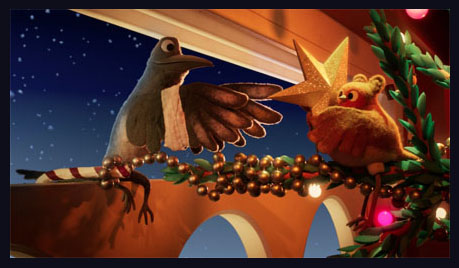
JM: Holiday specials going along with holiday books: that’s a perfect pairing right there. Families will definitely be thrilled with both experiences. One of the other things that was revealed in this presentation was that you two act out all of the scenes really early on in the process to feel everything out. So Dan and Mikey, how would you grade each other in terms of how you are as actors?
DO & MP: (laugh)
MP: For scenes we’d be like, “Well, I thought mine was kind of funnier.” “I didn’t like the way that was there.” “Your face is just wrong there.”
DO: You act something out because you only get one shot when you animate it to create the performance. You act it out first and you have to become the character. The good thing about it: you can film yourself 20 times doing a little thing and figure out, “That’s the performance.” Whereas on the floor when you’re animating, you get one shot and it takes a few days and then it comes back and you’re like, “Ah. That’s not what I thought.”
MP: That process was very helpful. This needs another second in between. Or there needs to be another word or grunt in there or something else you didn’t realize was missing until you actually embody that action. And it’s also a great fun way to inject some spontaneity into what can be a very, very… ironed pipeline of making a film.
- INTERVIEW: Strap In For “Mars Express” - April 30, 2024
- INTERVIEW: Jeff Fowler On “Knuckles” And “Sonic 3” - April 22, 2024
- INTERVIEW: “Inside Out 2” Director And Producer On Pixar Sequel - April 16, 2024


 November 8th, 2021
November 8th, 2021  Jackson Murphy
Jackson Murphy  Posted in
Posted in  Tags:
Tags: 






